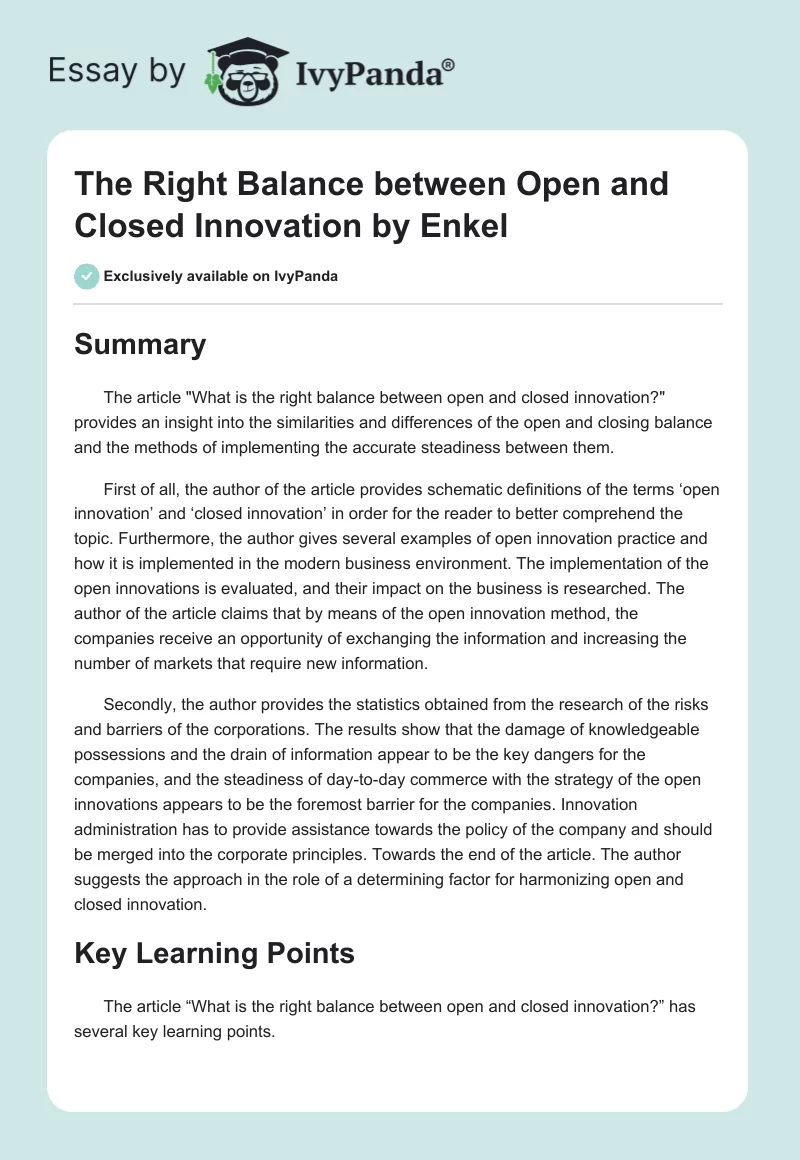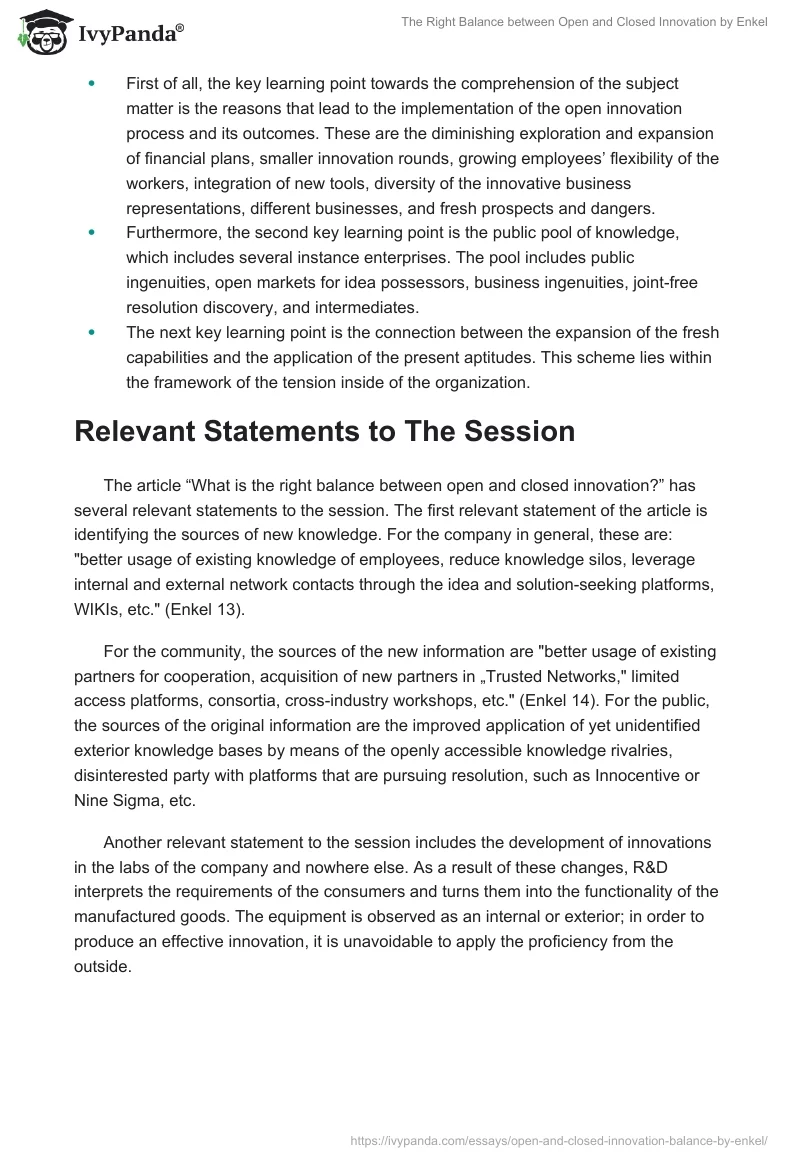Summary
The article “What is the right balance between open and closed innovation?” provides an insight into the similarities and differences of the open and closing balance and the methods of implementing the accurate steadiness between them.
First of all, the author of the article provides schematic definitions of the terms ‘open innovation’ and ‘closed innovation’ in order for the reader to better comprehend the topic. Furthermore, the author gives several examples of open innovation practice and how it is implemented in the modern business environment. The implementation of the open innovations is evaluated, and their impact on the business is researched. The author of the article claims that by means of the open innovation method, the companies receive an opportunity of exchanging the information and increasing the number of markets that require new information.
Secondly, the author provides the statistics obtained from the research of the risks and barriers of the corporations. The results show that the damage of knowledgeable possessions and the drain of information appear to be the key dangers for the companies, and the steadiness of day-to-day commerce with the strategy of the open innovations appears to be the foremost barrier for the companies. Innovation administration has to provide assistance towards the policy of the company and should be merged into the corporate principles. Towards the end of the article. The author suggests the approach in the role of a determining factor for harmonizing open and closed innovation.
Key Learning Points
The article “What is the right balance between open and closed innovation?” has several key learning points.
- First of all, the key learning point towards the comprehension of the subject matter is the reasons that lead to the implementation of the open innovation process and its outcomes. These are the diminishing exploration and expansion of financial plans, smaller innovation rounds, growing employees’ flexibility of the workers, integration of new tools, diversity of the innovative business representations, different businesses, and fresh prospects and dangers.
- Furthermore, the second key learning point is the public pool of knowledge, which includes several instance enterprises. The pool includes public ingenuities, open markets for idea possessors, business ingenuities, joint-free resolution discovery, and intermediates.
- The next key learning point is the connection between the expansion of the fresh capabilities and the application of the present aptitudes. This scheme lies within the framework of the tension inside of the organization.
Relevant Statements to The Session
The article “What is the right balance between open and closed innovation?” has several relevant statements to the session. The first relevant statement of the article is identifying the sources of new knowledge. For the company in general, these are: “better usage of existing knowledge of employees, reduce knowledge silos, leverage internal and external network contacts through the idea and solution-seeking platforms, WIKIs, etc.” (Enkel 13).
For the community, the sources of the new information are “better usage of existing partners for cooperation, acquisition of new partners in „Trusted Networks,” limited access platforms, consortia, cross-industry workshops, etc.” (Enkel 14). For the public, the sources of the original information are the improved application of yet unidentified exterior knowledge bases by means of the openly accessible knowledge rivalries, disinterested party with platforms that are pursuing resolution, such as Innocentive or Nine Sigma, etc.
Another relevant statement to the session includes the development of innovations in the labs of the company and nowhere else. As a result of these changes, R&D interprets the requirements of the consumers and turns them into the functionality of the manufactured goods. The equipment is observed as an internal or exterior; in order to produce an effective innovation, it is unavoidable to apply the proficiency from the outside.
Critical Analysis
What appears to be the perfect combination of open and closed innovation in order to make the most of the performance of the corporation? In order to provide an answer to this question, the policies and management styles of the corporation are needed to be evaluated, as the company’s tactic towards cooperative innovation appears to be reliant on the commercial approach. Consequently, it could be said that the organization is able to originate the equilibrium between the open and closed innovation presentations from their commercial approach (Huizingh 7).
Innovation nearly under no circumstances appears to be an either/or option. As most corporations have exposed (and as the author of the article has claimed), their innovation objectives include a compound mixture of closed and open innovation, which is exceptionally designed to fit the innovation purposes of the companies.
This compound mixture of closed and open innovation could be determined in accordance with several approaches. One method is to examine each novelty scheme with the help of three inquiries:
- What elements of the scheme are available to whom?
- What is the determination of them?
- Who has to remove the charge?
If these inquiries are questioned and replied to in the stage of development of a novelty scheme, both closed and open innovation arrangements could be designated and attuned in order to attain the innovation purposes of the company. These inquiries are, in fact resulting from three project values related to the novelty:
- architecture of participation,
- minimum effectual balance,
- worth abstraction and controller (Chesbrough 314).
Practical Implications
The approach of the closed Innovation has the role of a catalytic agent for invention, in view of the fact that a lot of the utmost discoveries in either the manufactured goods or facilities area had its early development in the precipitously combined example of closed innovation (Herzog 18).
The utmost instance of a closed innovation model is the corporation at 1 Infinite Loop, Cupertino (Aylen 69). Occupied behind the curtains of confidentiality and the infrequent tactical leakages, Apple has distributed one of the greatest merchandise in the history of technology manufacturing. The supporters of the open innovation approach have to come to an agreement that Apple‘s accomplishments rely on an innovative approach that is recognized as closed yet encouraging for directness. “The single maniacal direction enforced by Steve Jobs and the radical internalization of all branches of product development had brought out coherent products. They have managed to avoid ‘featuritis’ plaguing many ‘Open’ products” (Almirall 31).
Learning Reflections
I have acquired a new knowledge about the interconnection of the open and closed innovation and what impact it has on the company. Moreover, I have learned that open innovation is not able to exist purely without a close innovation and another way round. The new information towards the similarities and differences of the open and closing balance and the methods of implementing the accurate steadiness between them was acquired during the evaluation of the article.
Works Cited
Almirall, Esteve. “Open Versus Closed Innovation: A Model of Discovery and Divergence.” Academy of Management Review 35.1 (2010): 27-47. Print.
Aylen, Jonathan. “Open Versus Closed Innovation: Development Of The Wide Strip Mill For Steel In The United States During The 1920s.” R&D Management 40.1 (2010): 67-80. Print.
Chesbrough, Henry. “Open R&D and Open Innovation: Exploring The Phenomenon.” R&D Management 39.4 (2009): 311-316. Print.
Enkel, Ellen. What is the Right Balance between Open and Closed Innovation? Friedrichshafen, Germany: Zeppelin University, 2007. Print.
Herzog, Philipp. “Open and Closed Innovation – Different Innovation Cultures For Different Strategies.” International Journal of Technology Management 52.3 (2010): 17-23. Print.
Huizingh, Eelko. “Open Innovation: State Of The Art and Future Perspectives.” Technovation 31.1 (2011): 2-9. Print.


